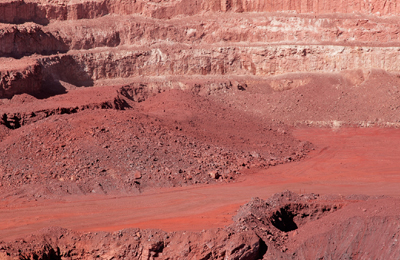
Iron ore ... miners struggle to stay in business.
Iron ore in fresh crisis as forward prices crumble
SINGAPORE, April 12, 2015
Iron ore is veering to a new crisis as prices for future delivery of the commodity slid 30 per cent in the space of a month, and its outlook is now more bearish than oil and more dire than ever for miners struggling to just stay in business.
Prices of the steel-making ingredient for immediate delivery have slumped 60 per cent over the past year as demand particularly from China slowed rapidly.
Despite the crumbling cash market, miners had been able to hedge future production at prices well above spot levels. Indeed, a month ago, miners could still sell 2017 output at close to $70 a tonne even as April 2015 prices fell below $60 for the first time in more than five years.
Forward iron ore prices have since tumbled below $47 for deliveries all the way until the end of 2017, depriving nearly all miners of any chance of establishing hedges at or above breakeven levels during that period.
A combination of factors brought about the recent capitulation in forward prices, most notably news that China plans to subsidise its iron ore sector to protect its flagging steel industry. Subsidies would help keep mines open and keep supplies flowing.
Aggressive shipments from Australian and Brazilian exporters have also weighed on forward prices.
As prices fall even further, "it will be an issue of cash flow, and those miners without the cash to ride out the storm are going to go under," said Jeremy Platt, analyst at London-based steel consultancy MEPS.
Only three of the world's top 10 largest iron ore miners are estimated to remain profitable at those prices, with Rio Tinto and BHP Billiton projected to have breakeven costs of around $35-36 a tonne and Fortescue estimated at around $44 a tonne, according to UBS.
All other miners, including the world's largest, Vale , are estimated to have production costs above $50 a tonne, and so are now faced with a quandary with nearby as well as deferred prices entrenched below that level.
Market participants say they are on the lookout for signs that high-cost producers outside of China may accelerate cutbacks in production amid deteriorating cash flows and limited revenue potential.
OIL LOOKING GOOD
The bleak outlook for iron ore contrasts with that of the crude oil market, which has also succumbed to a steep price slump over the past year. But according to the forward market, it has the potential to rebound strongly.
Indeed, crude oil traded on the New York Mercantile Exchange for delivery in late 2016 are nearly $10 a barrel above current levels, and so provide industry participants with hope that better days lie ahead.
That upbeat mindset was in evidence this week by the 50 per cent premium that Royal Dutch Shell offered for the shares of BG Group in a record $70 billion takeover. The deal has sparked expectations of a further wave of mergers and acquisitions in the energy arena.
In comparison, iron ore miners have struggled to find credit, with US investors reportedly selling out of Australian mining companies' bonds due to plunging iron ore prices.
Last month, Australia's Fortescue Metals Group Ltd, the world's fourth-largest iron ore miner, had to pull a $2.5 billion high-yield bond issue due to a lack of investor interest.
"It's a war of attrition, and it's going to be a pretty ugly situation for quite a long time, with iron ore prices staying fairly subdued over the medium term as supply pressures continue," MEPS's Jeremy Platt said. - Reuters







